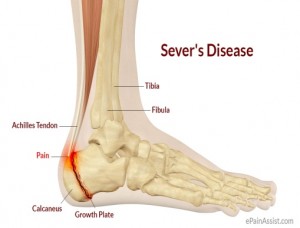Sever’s disease, also known as calcaneal apophysitis, is a common temporary heel injury that occurs in children. It is a painful condition that takes place in the heel that results in  inflammation at the growth plate (epiphyseal plate). As children grow, their bones have a region of developing cartilage cells located at the end of their bones, which is called the growth plate. Over time these cells transform into bone cells and the existing growth plate expands and joins to form mature bone.
inflammation at the growth plate (epiphyseal plate). As children grow, their bones have a region of developing cartilage cells located at the end of their bones, which is called the growth plate. Over time these cells transform into bone cells and the existing growth plate expands and joins to form mature bone.
This type of growth plate injury usually occurs in children who are physically active and during their growth spurt into adolescence that can be approximately a 2-year time period. For females this could be from 8-13 years of age and for males 10-15 years of age.
Cause
As the growth spurt of adolescence occurs, the heel (calcaneus) may grow at a faster rate than the muscles/tendons of the lower leg. This will cause the muscle/tendon to become tight creating inflexibility of the heel and calf which applies pressure onto the growth plate. The tendon that becomes overstretched is the Achilles tendon which attaches into the growth plate. Repetitive pressure applied to this tendon will over time cause inflammation, tenderness and pain to the growth plate which are all symptoms of Sever’s disease.
The following activities can create damage to the growth plate leading to Sever’s disease:
- Running and jumping typically on hard surfaces
- Soccer
- Basketball
- Track
- Gymnastics
These are a few activities that can result in Sever’s disease; however, this is not a complete list. There are other contributors that can result in this injury:
- Poor fitting shoes that do not give enough support
- Prolonged standing
- Flat or high arches
- Pronated foot (during walking the foot will roll inward)
- Obesity
- One leg shorter than the other
Signs and Symptoms
One of the hallmark signs of Sever’s disease is that your child will complain of pain in either one heel or both. There may also be swelling and redness. The pain will most likely be located at the back of the heel; however the pain can migrate to the sides and bottom of the heel. In most cases the pain is usually worse after activity. Your child may have difficulty walking or walk with a limp or tiptoe to avoid any pressure placed on the heel.
Treatment
Have your child cut down or stop any activity that causes heel pain. Apply ice to the injured heel for 20 minutes 3 times a day. If your child has a high arch, flat feet or bowed legs, your doctor may recommend orthotics, arch supports or heel cups. Your child should not walk barefoot with active Sever’s disease as this can increase the pain and inflammation. If your child has severe heel pain, medicines such as acetaminophen (one brand name: Tylenol) or ibuprofen (some brand names: Advil, Motrin) may help.
Stretching exercises for the hamstring and calf muscles will also be helpful. Each stretch should be performed 2 or 3 times a day, with each stretch being held for about 30 seconds. Be sure to stretch both legs, even if the pain is only in one heel.
(insert video of calf stretches)
Strengthening exercises to the muscles on the front of the shin and lower leg are also useful to help promote healing and recurrence of this injury.
Most cases of Sever’s disease will resolve usually within 2 weeks to 2 months provided that proper care and instructions were given to both the child and their parents. Most children will return to their activities without any reccurrence once the symptoms have subsided.
Remember the quicker Sever’s disease is addressed, the faster the recovery process.


